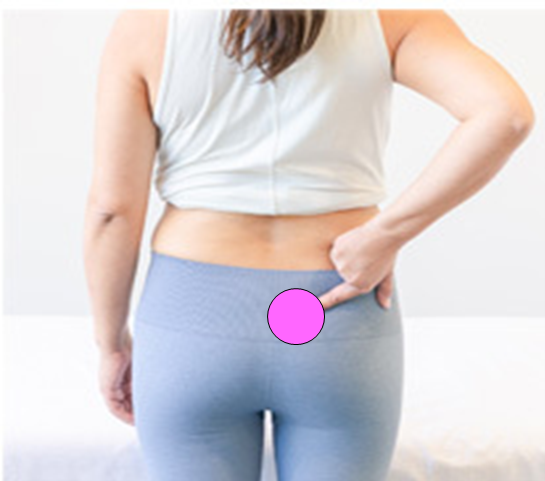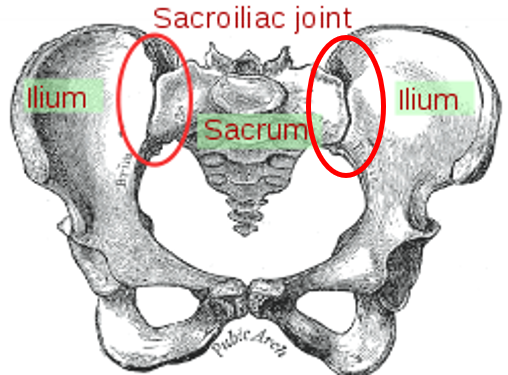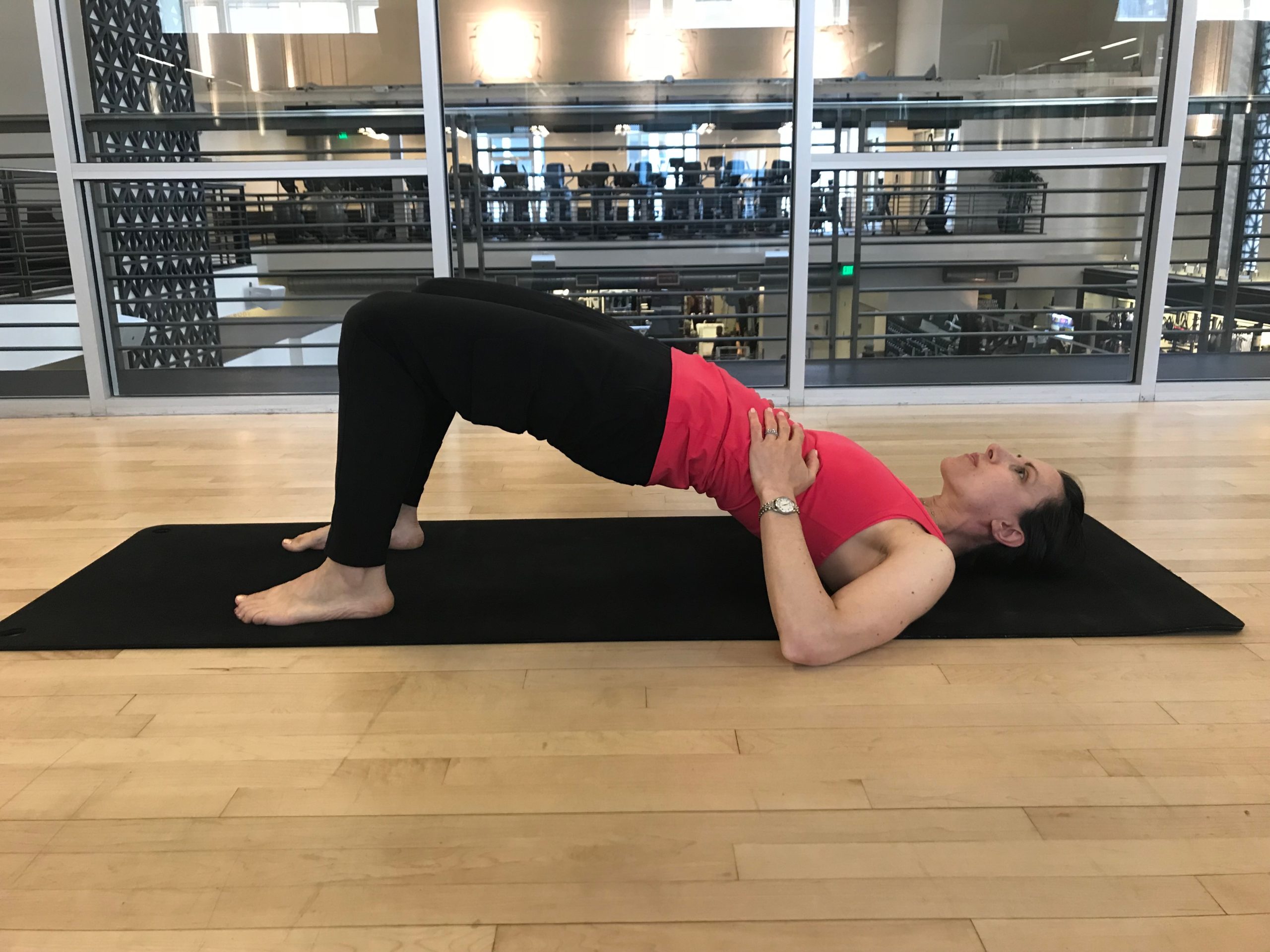There is certainly no shortage of pregnancy aches and pains, and sometimes it can be difficult to determine what exactly it is you are feeling and how to address it. One of the most common pains people experience is sacroiliac (SI) joint pain, but often we may not know that’s what it is, and so it can be difficult to determine how to alleviate the pain. Here are some tips to help you identify if you might have SI joint pain, then learn what to focus on (and avoid) to help mitigate it.
What SI Joint Pain Feels Like
SI joint pain is felt in the backside of your pelvis (around your buttocks), often felt on one side only (like in the image below). The pain can range from chronic and dull to sharp and shooting, sometimes radiating down your leg a bit. Often that pain is worsened by weight-bearing activity, especially on one leg (like stair climbing, doing the elliptical machine, taking an exercise class, or even long periods of walking).

What Causes SI Joint Pain
The human body has two SI joints (a left and a right) located in the posterior pelvic region between the sacrum and the ilium bones (hence the name sacroiliac joint).

During pregnancy, the following factors can place added stress on these joints, which can lead to pain:
- Hormonal Changes: During pregnancy, hormonal changes – including the increase in the hormone relaxin – can loosen the ligaments of the pelvis, making the SI joint more mobile than pre-pregnancy.
- Insufficient Glute Strength: The glutes are critical in stabilizing the pelvis and, by extension, the SI joints. Due to pregnancy weight gain, the added body mass can become more difficult for the glutes to support, especially during single-leg activities.
- Increased Body Weight: The increased weight as pregnancy progresses elevates the forces going through the pelvis, which accentuates the two issues above.
Since some hormonal changes from pregnancy — including the impact of relaxin — continue into the postpartum period, the hypermobility of the SI joint could still be present after giving birth, so that is why SI joint pain can also occur in the postpartum period.
Exercises to manage (or prevent) SI Joint Pain
The following three strategies are great for prevention and pain management.
- Neutral Alignment: This first one is not really an “exercise,” but incredibly important in alleviating stress on the SI joint. Unfortunately, the physical and physiological changes of pregnancy can pull the body out of neutral alignment, which could worsen the impact from the causes stated above. To address, practice getting your body — especially your pelvis — into neutral alignment to alleviate stress on the SI joint.
- 360° Breathing: The deep core muscles (diaphragm, transverse abdominis, and pelvic floor) help to support and stabilize the pelvis (and therefore minimize SI joint pain). Begin by practicing 360° Breathing (the #1 most effective core exercise) because it activates these deep core muscles and gets them to work together in a coordinated fashion. Master this movement first, then practice incorporating it into all the other exercises below (as demonstrated in the video).
- Pelvic Floor Activations (PFAs): One of the key responsibilities of the pelvic floor muscles is to assist in stabilizing the pelvis. Therefore, it’s important to target these critical deep core muscles with exercises we refer to as PFAs.
- Bridges: As mentioned above, insufficient glute strength can be a key contributor to SI joint pain because the glutes work with your core to stabilize your pelvis. Bridges are a great way to target your glutes because they keep your pelvis in a stable position. Don’t worry, it is fine to be on your back for short durations during pregnancy as long as you feel comfortable.
- Clamshells: These are also great at targeting the glutes in a safe non-weight bearing way. Be sure to follow the technique pointers in this video to ensure you get the most out of the movement.
- Ground Pickup (or Deadlift): The Ground Pickup is essentially a Deadlift, but we refer to it this way because we want you to associate this action with how you pick things up off the ground in your daily life. If you can train yourself to naturally bend over in neutral alignment (maintaining a straight line between ear-shoulder-hip), you’ll be strengthening your glutes and protecting your core. Once you’ve mastered, increase the challenge by lifting heavier objects.
- Straight Arm Pull-Downs: This move targets your lats, which help stabilize your pelvis. You will need a resistance band for it. We recommend this Theraband variety pack, which includes three bands so you have a few different resistance levels to work with. You can tie it to something or use this very simple and inexpensive door anchor.
- Single-Arm Bent Over Row: This is also a great movement to target the lats to help stabilize your pelvis. It uses the same resistance band as above. If you need more support for your lower back, try this single arm supported row.
- Incline Plank: A plank targets the core muscles at the front of your body, which can help resist common anterior pelvic tilt (alignment shift) during pregnancy. Of course, as the belly grows, you’ll need to begin regressing full center planks to avoid too much direct downward facing pressure on the belly. Incline planks are a great option. Get more guidance on planks by trimester in this post on planks during pregnancy.
Movements to Avoid to Avoid
All the movements above are also great ways to prevent SI Joint pain in the first place. If, however, you are experiencing pain, then you’ll want to limit single-leg weight bearing activity as much as possible to keep your pelvis in a more stable position. This includes things like the following:
- Lunges or step-ups: Single-leg lower body moves like lunges of any kind or step-ups/downs place your pelvis in a less stable position. In general, you want to keep your weight evenly distributed over two feet (think squats, deadlifts, floor bridges, etc).
- Impact: Impact moves like running, jumping, or other ballistic moves will likely aggravate pain given the hypermobility in your pelvis. Your body will likely tell you these moves are not appropriate.
- Traditional cardio machines: Machines like the elliptical, Stairmaster, and treadmill all promote single-leg activities, so it is best to avoid these.
- Crossing your legs when seated: Sitting cross-legged can pull your pelvis out of alignment, which can aggravate the SI joint and encourage hypermobility. Instead, try to sit tall with both feet flat on the floor.
- Deep single-leg stretches: Deep, single-leg stretches (like “figure four” or “pigeon pose”) can also aggravate the SI joint and encourage hypermobility.
- Any move that triggers pain: Sometimes the pain triggers are different for every individual, so try to pay attention to the activities that trigger pain for you. This can sometimes be tricky because you may not feel the pain until the next day, so you may have to think back to what you did the day prior.
Finally, there are many single-leg activities you perform throughout your day — like walking, climbing stairs, and getting up and down from the ground. Of course, it’s not possible to completely avoid these activities, and we wouldn’t want you to either. It’s important to keep moving. You may just want to limit extended periods of walking or stair climbing when pain is severe. Also, when getting up off the ground, step up on the side that does not hurt.
Additional Support
- Explore our prenatal self-guided training programs. These programs progress you through an entire training program tailored to your stage to help you build strength and prepare your body for a smoother pregnancy, easier delivery, and faster recovery. All programs also come with a pelvic pain modifications guide to help you modify any single-leg movements if you are experiencing SI joint pain.
“This program totally transformed my pregnancy! Prior to starting, I was experiencing significant SI joint pain, so I had started physical therapy around 15 weeks. I attempted to modify my workouts, but I felt like I was flailing. Around 24 weeks, I discovered the ProNatal program. I am now 32 weeks along and I feel so strong! I am moving about my day with much greater ease (and less pain!), I’m sleeping better, and I can even lift and carry my 35 lb 4-year-old (something I couldn’t even consider earlier on in my pregnancy). This program was a complete game-changer for me!”
Alissa, mom to 4yo and 32wks pregnant
- If you have painful symptoms, consider wearing a compression garment. We love the range from SRC Health, which offers high-quality garments to wear under and over your bump (use code PRONATAL10 for 10% off).
Are you a Health & Fitness Professional?
If you are interested in training pre & postnatal clients — or simply supporting them better in your classes — explore our ProNatal Education & Certification. Select from the full certification or the “mini course” for Group Fitness Instructors.
Affiliate Notification: The post contains an affiliate link for SRC health. We may earn a commission from purchases made through this link. However, we only endorse companies that we have personally vetted and believe in.
